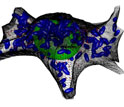|

Press Release 04-076
Staying on the Path – One Atom at a Time

New percolation model may allow researchers to study biochemistry at the atomic level

Surface rendering of a neuron. A Delauney tessellation scheme was used to discretize the volume. ...
Credit and Larger Version |
May 27, 2004
ARLINGTON, Va.—A new report in the May 24 Proceedings of the Royal Society of London. Series A: Mathematical and Physical Sciences announces a mathematical model that will help researchers understand "cell signaling" and learn how single atoms travel along the circuitous pathways in a cell.
The model is a new approach to look at percolation—the flow of a liquid or small particle through a porous material. In the simulation, materials pass through fields of complex, three-dimensional shapes, a scenario that is closer to real-world environments than existing two-dimensional models and models incorporating simpler shapes.
The model was developed by Ann Marie Sastry and Yun-Bo Yi, both of the University of Michigan. The researchers will use their findings in a larger study that will deploy sensor proteins inside a cell where the nanoscale devices will track the paths of ions.
The model reveals how the sensors might interact with the miniscule ions that contribute to such diseases as stroke, cardiovascular disease and cancer. With the proper experimental design, the researchers may be able to watch fundamental chemical reactions—at the molecular level—as they occur in living cells.
In addition to biological applications, the simulation will help researchers develop new materials by revealing better ways to craft porous substances. By understanding the properties of these types of materials, researchers can enhance conductivity in batteries, flow paths in filters and numerous other percolation mechanisms.
Sastry won a 1997 NSF Presidential Early Career Award for Scientists and Engineers (PECASE), the highest honor bestowed by the United States government on scientists and engineers beginning their independent research careers. The NSF support from that award contributed to the development of the percolation model.
Support for the work was also provided by the Defense Advanced Research Projects Agency (DARPA) and the Office of Naval Research through the Synthetic Multifunctional Materials Program, managed by Leo Christodoulou of DARPA, and the W.M. Keck Foundation.
NSF comments regarding the Sastry research group:
"With her PECASE award, Ann Marie Sastry has expanded her research focus from a single area in mechanical engineering, materials processing, into a broad exploration to uncover fundamental knowledge. She has demonstrated an ability to take advantage of support to move beyond her own initial training and move out to address societal needs." - Delcie Durham, program director in NSF’s Division of Design, Manufacture and Industrial Innovation who oversaw Sastry's five-year award.
"Because of her interests and abilities, Sastry has attracted a diverse team of students and guided them to address core areas within mechanical engineering. Sastry has expanded her research to address fundamental issues in mathematics, biology and energy." - Delcie Durham
"Sastry has been an articulate voice for manufacturing as a viable research and educational endeavor and a proponent of diversity as a critical component of these efforts." – Delcie Durham
-NSF-
University of Michigan Press Release:
http://www.umich.edu/news/index.html?Releases/2004/May04/r051904c
Sastry's Heterogeneous Multiscale Materials Laboratory at the University of Michigan:
http://www-personal.engin.umich.edu/~amsastry/
PECASE Award Information:
http://www.nsf.gov/home/crssprgm/pecase/start.htm
CAREER Award Information:
http://www.nsf.gov/home/crssprgm/career/start.htm

Media Contacts
Josh Chamot, NSF (703) 292-7730 jchamot@nsf.gov
Laura Bailey, University of Michigan (734) 647-1848 baileylm@engin.umich.edu
Principal Investigators
Ann Marie Sastry, University of Michigan (734) 764-3061 amsastry@umich.edu

The National Science Foundation (NSF) is an independent federal agency that
supports fundamental research and education across all fields of science and
engineering, with an annual budget of $6.06 billion. NSF funds reach all 50
states through grants to over 1,900 universities and institutions. Each year,
NSF receives about 45,000 competitive requests for funding, and makes over
11,500 new funding awards. NSF also awards over $400 million in
professional and service contracts yearly.
 Get News Updates by Email Get News Updates by Email
Useful NSF Web Sites:
NSF Home Page: http://www.nsf.gov
NSF News: http://www.nsf.gov/news/
For the News Media: http://www.nsf.gov/news/newsroom.jsp
Science and Engineering Statistics: http://www.nsf.gov/statistics/
Awards Searches: http://www.nsf.gov/awardsearch/
| 



